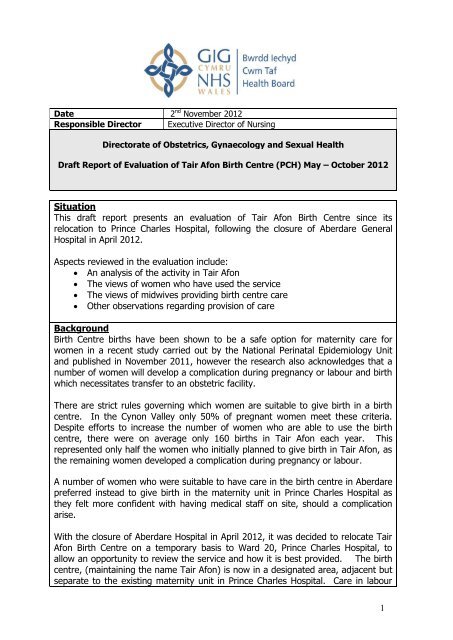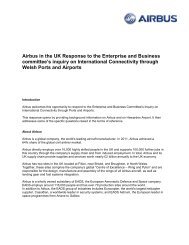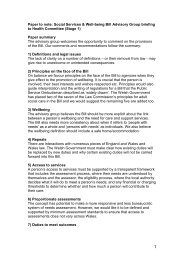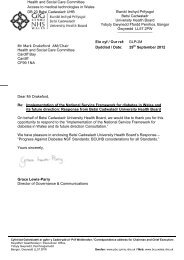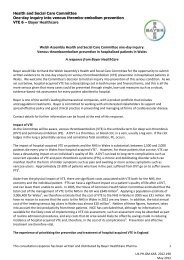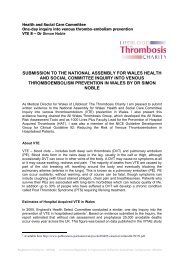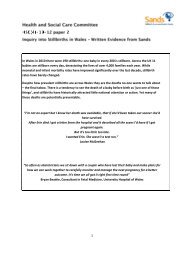Response to action point - Cwm Taf HB-3 (Saesneg yn unig)
Response to action point - Cwm Taf HB-3 (Saesneg yn unig)
Response to action point - Cwm Taf HB-3 (Saesneg yn unig)
You also want an ePaper? Increase the reach of your titles
YUMPU automatically turns print PDFs into web optimized ePapers that Google loves.
Date 2 nd November 2012<br />
Responsible Direc<strong>to</strong>r Executive Direc<strong>to</strong>r of Nursing<br />
Direc<strong>to</strong>rate of Obstetrics, G<strong>yn</strong>aecology and Sexual Health<br />
Draft Report of Evaluation of Tair Afon Birth Centre (PCH) May – Oc<strong>to</strong>ber 2012<br />
Situation<br />
This draft report presents an evaluation of Tair Afon Birth Centre since its<br />
relocation <strong>to</strong> Prince Charles Hospital, following the closure of Aberdare General<br />
Hospital in April 2012.<br />
Aspects reviewed in the evaluation include:<br />
An analysis of the activity in Tair Afon<br />
The views of women who have used the service<br />
The views of midwives providing birth centre care<br />
Other observations regarding provision of care<br />
Background<br />
Birth Centre births have been shown <strong>to</strong> be a safe option for maternity care for<br />
women in a recent study carried out by the National Perinatal Epidemiology Unit<br />
and published in November 2011, however the research also acknowledges that a<br />
number of women will develop a complication during pregnancy or labour and birth<br />
which necessitates transfer <strong>to</strong> an obstetric facility.<br />
There are strict rules governing which women are suitable <strong>to</strong> give birth in a birth<br />
centre. In the C<strong>yn</strong>on Valley only 50% of pregnant women meet these criteria.<br />
Despite efforts <strong>to</strong> increase the number of women who are able <strong>to</strong> use the birth<br />
centre, there were on average only 160 births in Tair Afon each year. This<br />
represented only half the women who initially planned <strong>to</strong> give birth in Tair Afon, as<br />
the remaining women developed a complication during pregnancy or labour.<br />
A number of women who were suitable <strong>to</strong> have care in the birth centre in Aberdare<br />
preferred instead <strong>to</strong> give birth in the maternity unit in Prince Charles Hospital as<br />
they felt more confident with having medical staff on site, should a complication<br />
arise.<br />
With the closure of Aberdare Hospital in April 2012, it was decided <strong>to</strong> relocate Tair<br />
Afon Birth Centre on a temporary basis <strong>to</strong> Ward 20, Prince Charles Hospital, <strong>to</strong><br />
allow an opportunity <strong>to</strong> review the service and how it is best provided. The birth<br />
centre, (maintaining the name Tair Afon) is now in a designated area, adjacent but<br />
separate <strong>to</strong> the existing maternity unit in Prince Charles Hospital. Care in labour<br />
1
number of women<br />
continues <strong>to</strong> be provided by the birth centre midwives from C<strong>yn</strong>on Valley, in the<br />
same way that it was formerly provided.<br />
Antenatal care facilities were transferred as planned <strong>to</strong> Ysbyty <strong>Cwm</strong> C<strong>yn</strong>on, when<br />
Aberdare Hospital closed.<br />
Assessment<br />
Activity in the birth centre<br />
The number of intended and actual births and transfers in the antenatal period<br />
and during labour were compared between 2011 and 2012, in the six-month<br />
period May <strong>to</strong> Oc<strong>to</strong>ber. The same months were used <strong>to</strong> allow for the seasonal<br />
variation in the number of births. The overall birth numbers for Prince Charles<br />
Hospital were very similar in both years, showing that the change in numbers<br />
was not attributable <strong>to</strong> a large increase or decrease in the overall birth rate.<br />
Comparison 2011 / 2012<br />
180<br />
160<br />
140<br />
120<br />
100<br />
80<br />
60<br />
intended<br />
actual births<br />
AN transfers<br />
labour transfers<br />
40<br />
20<br />
0<br />
2011 2012<br />
The number of women intending <strong>to</strong> use the birth centre rose following<br />
relocation <strong>to</strong> Prince Charles Hospital, as did the actual number of births. There<br />
was also a rise in the number of antenatal transfers of women, with<br />
proportionally more women during 2012 (34% of women, compared <strong>to</strong> 28% of<br />
women in 2011), although the reasons for this were not explored further.<br />
Labour transfers from Tair Afon Prince Charles increased, which is consistent<br />
with figures from other birth centres located alongside obstetric units.<br />
These results show that the <strong>to</strong>tal number of women who intended <strong>to</strong> give birth<br />
in the birth centre rose by 22% following relocation of the unit <strong>to</strong> Prince<br />
Charles Hospital – it is presumed that this represents the number of women<br />
suitable for birth centre care but who would previously have chosen <strong>to</strong> give<br />
birth in Prince Charles Hospital. Proportionally, the number of women actually<br />
giving birth also rose in 2012, with 86% of women who began labour* in the<br />
birth centre doing so, compared <strong>to</strong> 71% during 2011.<br />
2
*(i.e not including the number of women who were transferred antenatally).<br />
Women’s Views<br />
(Please note that as the evaluation finished on 31 st Oc<strong>to</strong>ber, there are still a<br />
number of evaluation forms outstanding, which when received will give a more<br />
robust representation of women’s views).<br />
Women who had used the birth centre in Prince Charles Hospital (PCH) were<br />
asked <strong>to</strong> complete a questionnaire giving their views of the service provided.<br />
The questionnaire was approved for use by the Health Board’s Research and<br />
Development Group, and given out by the community midwife following birth.<br />
Women were asked <strong>to</strong> rate satisf<strong>action</strong> with aspects of their care, and about<br />
the birth pool. The questionnaire also asked if women would choose birth<br />
centre care in a future pregnancy, and if so, where they would like this <strong>to</strong> be<br />
located – Ysbyty <strong>Cwm</strong> C<strong>yn</strong>on or Prince Charles Hospital. Women who had had<br />
a previous birth in the birth centre in Aberdare were asked <strong>to</strong> compare their<br />
experiences, and again give their views on a permanent location for the birth<br />
centre.<br />
There has been a disap<strong>point</strong>ing response <strong>to</strong> this aspect of the evaluation so far<br />
with only 25% of responses received <strong>to</strong> date, although the <strong>to</strong>tal response rate<br />
is not yet established. However some clear themes and opinions have already<br />
been expressed.<br />
The majority of women were satisfied with their care, and found the birth<br />
centre environment on ward 20 <strong>to</strong> be welcoming. Women were appreciative of<br />
their midwives, and all women said that they would choose birth centre care<br />
again.<br />
Four women preferred the birth centre <strong>to</strong> be located in Ysbyty <strong>Cwm</strong> C<strong>yn</strong>on<br />
(YCC), whilst 3 women felt it was important that the birth centre was near <strong>to</strong><br />
the obstetric unit. The remaining women did not have a particular preference<br />
– what was important <strong>to</strong> all women was the option of having a birth centre,<br />
rather than its location.<br />
The reasons women gave for preferring the birth centre in YCC was the travel<br />
time <strong>to</strong> PCH, particularly when in labour, or if needing <strong>to</strong> attend the birth<br />
centre <strong>to</strong> see their midwife for reassurance (for example, if the woman thought<br />
she was in labour, but was not).<br />
One woman preferring PCH as the location explained that she had needed<br />
transfer during labour in a previous birth, so the location in PCH was much<br />
more reassuring, should the same thing have been required again.<br />
For the women who had previously given birth in Aberdare, although the<br />
further travelling distance <strong>to</strong> PCH was mentioned, overall, women found their<br />
experience <strong>to</strong> be enjoyable and comparable <strong>to</strong> that in Aberdare.<br />
The birth pool was installed at the end of May, and after this date, all women<br />
3
who wished <strong>to</strong> use the pool were able <strong>to</strong>, if time allowed (78% of<br />
respondents). This shows the importance that women place on having access<br />
<strong>to</strong> a birth pool in labour.<br />
The conclusion so far from the women’s views is that birth centre care is an<br />
important option, and this is more important than the actual final location.<br />
Birth Centre Midwives’ Views<br />
Midwives had a pragmatic approach <strong>to</strong> the relocation of Tair Afon – having the<br />
birth centre located adjacent <strong>to</strong> the obstetric unit had required some<br />
adjustment <strong>to</strong> their working schedules, but they all agreed that this was<br />
balanced out by transfer during labour being much easier <strong>to</strong> accommodate. All<br />
midwives had at one time or another had <strong>to</strong> wait for a prolonged period of time<br />
for availability of an ambulance <strong>to</strong> transfer a woman in labour from Aberdare,<br />
and this was both stressful and associated with elements of risk <strong>to</strong> mother and<br />
/ or baby.<br />
Midwives also mentioned that some women found travel <strong>to</strong> PCH difficult<br />
overnight, and if for example, the woman had no transport <strong>to</strong> get home again,<br />
then she would require admission <strong>to</strong> the birth centre, when this was<br />
unnecessary.<br />
Following discussion with the birth centre midwives, it is apparent that they<br />
concur with the views of the women – that it is important <strong>to</strong> be able <strong>to</strong> provide<br />
birth centre care <strong>to</strong> women, irrespective of where this is located.<br />
Other Observations<br />
During the six-month evaluation period, 51 admission assessments were<br />
carried out on women in the birth centre, where there was a query regarding<br />
the onset of labour, or whether the membranes had ruptured. These were<br />
mostly carried out during the night, as the midwife was likely <strong>to</strong> see the women<br />
at home or in YCC during the day. All these women were later discharged<br />
home <strong>to</strong> await events.<br />
Consideration of lone worker issues means that midwives do not usually see<br />
women at home out of hours, unless they feel that it is safe <strong>to</strong> do so. On some<br />
occasions, the on-call midwife will already be in the birth centre thus needing<br />
the woman <strong>to</strong> attend PCH. The provision of a suitable facility <strong>to</strong> use out of<br />
hours in YCC would reduce travel for both midwives and mothers in most<br />
instances, however, current out-patient areas are not suitable for out-of-hours<br />
lone-worker use.<br />
The number of transfers during labour is slightly higher in PCH, although this is<br />
a recognised occurrence where birth centres are located alongside obstetric<br />
facilities, attributable <strong>to</strong> the birth taking place before transfer is expedited, in a<br />
stand-alone birth centre. Conversely, two women whose baby needed a<br />
paediatric review following birth were able <strong>to</strong> remain in Tair Afon PCH, as the<br />
paediatrician attended the birth centre and reviewed the baby. These women<br />
would have required transfer, had the birth centre remained in C<strong>yn</strong>on Valley.<br />
4
Eight women from the Merthyr Valley used the birth centre <strong>to</strong> facilitate a<br />
planned pool birth during the six month period.<br />
Conclusions<br />
The relocation of the birth centre <strong>to</strong> PCH has meant that the number of C<strong>yn</strong>on<br />
Valley women choosing this option has increased, and all women who<br />
responded in the questionnaire confirmed that the option of having a birth<br />
centre was important <strong>to</strong> them.<br />
The location of the birth centre was of lesser importance than a birth centre<br />
per-se <strong>to</strong> most women, although views for both PCH and YCC were expressed.<br />
Women disliked the travel <strong>to</strong> PCH, but this was balanced by the ease of<br />
transfer <strong>to</strong> obstetric care, should this be necessary.<br />
The birth pool was an important issue for women, and most women wanted <strong>to</strong><br />
use the pool during labour, if not for birth.<br />
An area in C<strong>yn</strong>on Valley <strong>to</strong> asses women who are not in obvious labour would<br />
be beneficial for use out of hours, although this option would depend on the<br />
availability of the on-call midwife.<br />
If all suitable women from the Merthyr Valley also used the birth centre, the<br />
numbers would greatly increase.<br />
Recommendations<br />
It is recommended that the executive board consider the evaluation presented<br />
above, when considering the final location for Tair Afon Birth Centre.<br />
Dr. Liz Edwards<br />
Senior Midwife<br />
5


